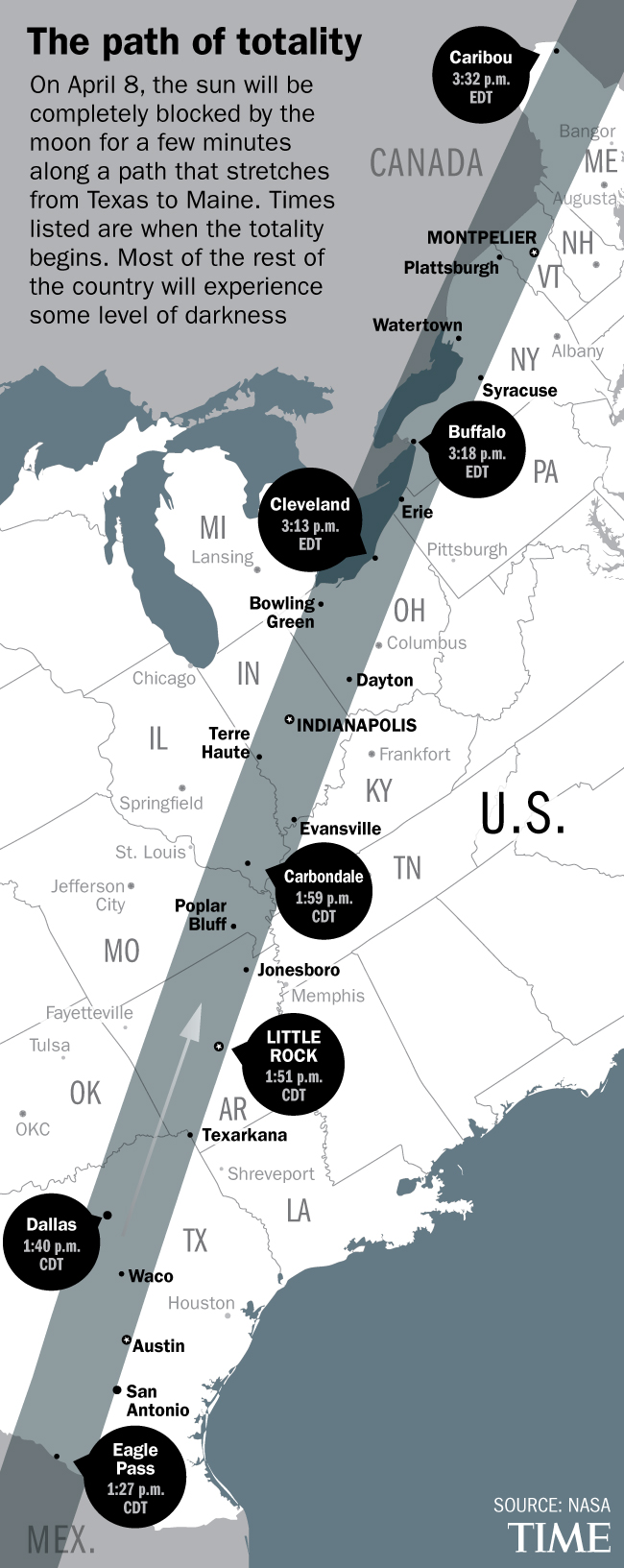A rare total solar eclipse will occur across Mexico, the U.S., and Canada on April 8, 2024. A solar eclipse occurs when the moon passes between the Earth and the Sun, blocking the sun’s rays during the day time, causing a temporary period of darkness.
If you would like to see the total solar eclipse, you will need to visit one of the places along the total eclipse path, which you can learn more about by viewing this map. Some of the largest American cities the eclipse will pass through are Cleveland, Ohio, Indianapolis, Indiana, and Dallas, Texas.
A total solar eclipse can last for up to a maximum of seven and a half minutes, according to NASA. During the period of totality, the time during which the sun is 100% covered by the moon, the sky will darken as though it is dusk or dawn. You can also expect the temperature to drop by approximately 10 degrees Fahrenheit depending on humidity levels and cloud coverage. For best viewing, try to find a place that has few clouds and gives you a direct view of the sky.
The exact timing of the eclipse will depend on which city you are based in. To find out when the eclipse will occur in your town, you can go to the Eclipse 2024 website. In Dallas, the total eclipse will begin at 1:40 p.m. local time. In Indianapolis, it will start at 3:06 p.m. and in Cleveland, it will begin at 3:13 p.m. local time. In all three cities, it is expected to last approximately 3 minutes and 50 seconds.
If you aren’t near a city in the direct path of the eclipse, you should still be able to at least witness a partial eclipse if you are in the continental U.S.
What makes this solar eclipse so special
Total solar eclipses are rare events to begin with, only occurring approximately once every 18 months. Often, they occur in remote areas or in the open ocean, where there are few people available to witness the event.
This eclipse is one of the few to pass through such a densely populated area, and will also occur while the sun will be at the peak of its activity cycle. The sun goes through 11-year cycles during which the levels of solar flares, sunspots, and solar radiation ebb and flow. The last time the continental U.S. experienced a solar eclipse was in 2017, when the sun’s activity was at minimal levels.
Because this time, the sun’s activity will be at close to peak levels, the view of the corona, the aura surrounding the sun, will be much different from last time, according to experts quoted in the Scientific American. This solar eclipse, you may see a larger corona with outflows and spikelike structures caused by the sun’s heightened activity. The corona is only safe to look at when the sun is behind the moon during the period of totality of the eclipse.
How to view the eclipse

Viewers should also make sure to wear special eclipse glasses, as looking at the sun directly can cause eye damage. Regular sunglasses do not provide enough protection to view an eclipse, according to NASA. The American Astronomical Society provides a list of eclipse eye protection suppliers that comply with international safety standards.
Alternatively, you can use a piece of cardboard and tin foil to create your own pinhole camera, and view the reflection of the eclipse that way, according to NASA. To try this, cut a one inch hole in the middle of one piece of cardboard, then tape a piece of tin foil onto the hole. Poke a small hole into the tin foil, and hold the cardboard a few feet away from the ground and cast your gaze to the shadow that the cardboard crates.
In the middle of the shadow, you should be able to see a small patch of light from the pinhole you poked. During the earlier phase of the partial eclipse, that patch of light will be shaped in the form of a crescent. The crescent will slowly become smaller as the total eclipse gets closer until it disappears from view.
More Must-Reads from TIME
- Cybersecurity Experts Are Sounding the Alarm on DOGE
- Meet the 2025 Women of the Year
- The Harsh Truth About Disability Inclusion
- Why Do More Young Adults Have Cancer?
- Colman Domingo Leads With Radical Love
- How to Get Better at Doing Things Alone
- Michelle Zauner Stares Down the Darkness
Contact us at letters@time.com